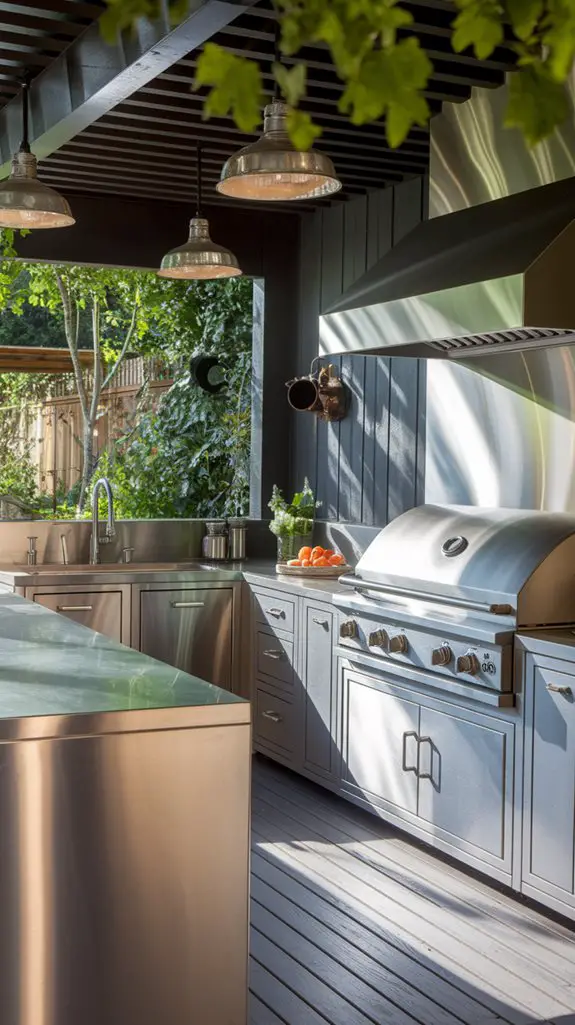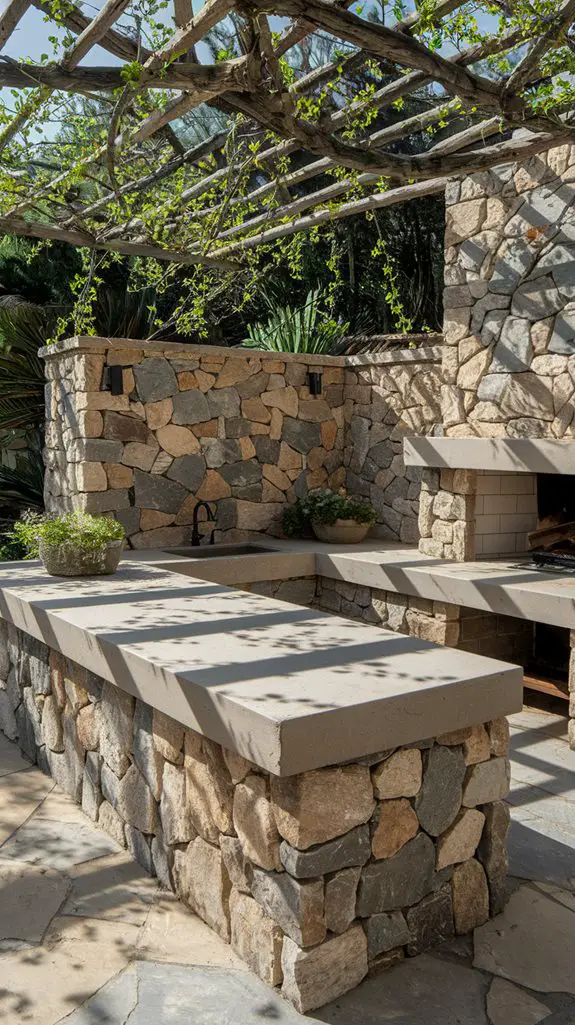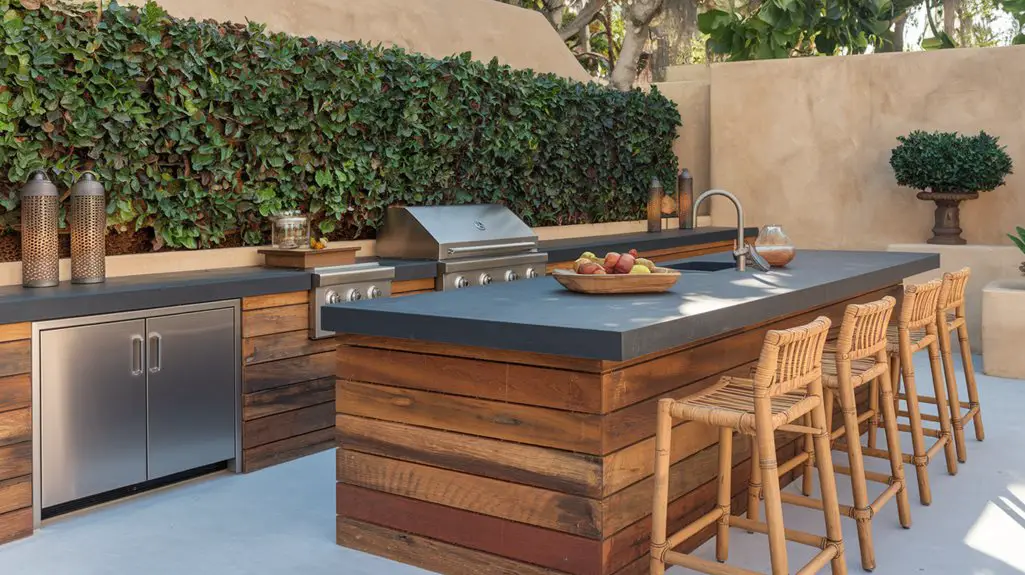When Sarah transformed her concrete patio into an outdoor kitchen using reclaimed redwood and recycled metal fixtures, she saved over $2,000 while creating a space that garnered neighborhood admiration. You’ll find that sustainable materials offer this dual advantage of environmental responsibility and distinctive character. From locally quarried stone to bamboo cabinetry, your choices can greatly reduce carbon footprint while enhancing durability. The right eco-friendly materials won’t just survive the elements—they’ll tell a story.
Reclaimed Wood for Cabinetry and Countertops
While many homeowners overlook its potential, reclaimed wood offers a compelling sustainability story for your outdoor kitchen design. By repurposing timber from old barns, factories, and warehouses, you’re diverting materials from landfills while reducing demand for newly harvested trees.
For outdoor kitchen applications, select dense, naturally rot-resistant woods like teak, cedar, or cypress. Apply marine-grade sealants to protect against moisture, UV damage, and temperature fluctuations. These treatments extend the wood’s functional lifespan without compromising its natural character.
The aesthetic benefits are equally impressive—each piece carries unique weathering patterns, nail holes, and grain variations that new lumber simply can’t replicate. Additionally, using renewable resources not only enhances your outdoor space but also supports a more sustainable environment.
You’ll enjoy both environmental benefits and a distinctive design element that connects your outdoor space to architectural history.
Recycled Metal Fixtures and Appliances

Just as reclaimed wood brings sustainability to your cabinetry, recycled metal components offer significant environmental benefits for your outdoor kitchen fixtures and appliances.
By choosing recycled aluminum, copper, or steel elements, you’re reducing mining impacts while creating a space that’s both eco-conscious and stylish.
- Brushed recycled stainless steel grills that reduce carbon footprint by 60% compared to conventional models
- Weathered copper range hoods crafted from repurposed industrial materials
- Salvaged aluminum sink fixtures that resist corrosion for decades of outdoor use
- Upcycled metal cabinet hardware offering industrial-chic aesthetics with minimal environmental impact
- Repurposed steel framing that provides superior durability against elements while diverting materials from landfills
These recycled metal options not only conserve resources but typically outlast conventional alternatives, making them wise long-term investments for your outdoor culinary space. Additionally, incorporating eco-friendly options like recycled metal can enhance the sustainability of your overall outdoor design.
Natural Stone Options: Locally Sourced and Durable

Natural stone serves as the cornerstone of sustainable outdoor kitchen design, offering unmatched durability and timeless beauty while minimizing transportation emissions. When you source limestone, granite, or sandstone locally, you’re reducing your carbon footprint while supporting regional economies. Additionally, using durable materials in your design ensures that your outdoor kitchen can withstand the elements for many years to come.
| Stone Type | Lifespan (years) | Sustainability Features |
|---|---|---|
| Granite | 100+ | Heat-resistant, minimal maintenance |
| Soapstone | 100+ | Non-porous, chemical-free cleaning |
| Limestone | 80-100 | Local availability, natural aesthetics |
| Slate | 75-100 | Weather-resistant, recyclable |
| Quartzite | 100+ | Extremely durable, low embodied energy |
Choose stones that haven’t undergone extensive processing. Reclaimed stone offers even greater ecological benefits, giving new life to materials with centuries of character. Your outdoor kitchen will age gracefully, developing a natural patina that enhances its connection to the surrounding landscape.
Bamboo and Sustainable Hardwoods for Structures
Beyond stone, the framework of your outdoor kitchen deserves materials that match sustainability with performance.
When selecting wood elements, prioritize FSC-certified hardwoods that resist outdoor elements naturally without chemical treatments. Bamboo offers exceptional renewability—reaching harvest maturity in just 3-5 years—while providing surprising durability for cabinets and accent pieces.
- Teak cabinetry with natural oils that repel water and insects, eliminating the need for synthetic sealants
- Reclaimed barn wood shelving that brings weathered character while giving old-growth timber new life
- Black locust posts and beams that resist rot for decades without pressure treatment
- Bamboo countertop sections that create visual warmth against cooler stone elements
- Eucalyptus furniture made from managed plantations where harvest cycles support carbon sequestration
Incorporating eco-friendly outdoor kitchens into your design not only enhances aesthetics but also contributes to a healthier environment.
Recycled Glass and Concrete Countertops
While traditional granite and marble dominate many kitchen designs, recycled glass and concrete countertops offer superior environmental credentials without sacrificing beauty or function.
These innovative surfaces repurpose waste materials that would otherwise end up in landfills. You’ll find endless customization possibilities with recycled glass embedded in concrete—from subtle flecks to bold mosaic-like patterns. The glass components can include everything from bottles to windshields, while the concrete often incorporates fly ash, a coal combustion byproduct.
These countertops aren’t just eco-friendly; they’re remarkably durable and heat-resistant. With proper sealing, they’ll withstand years of outdoor cooking and entertaining. Additionally, using sustainable materials for your outdoor kitchen can significantly reduce your carbon footprint.
They’re also locally producible, reducing transportation emissions compared to imported stone slabs. Consider these sustainable surfaces for a unique outdoor kitchen that aligns with your environmental values.
Plant-Based and Non-Toxic Finishes and Sealants
To truly complete your sustainable outdoor kitchen, you’ll need to contemplate what protects your materials just as carefully as the materials themselves.
Plant-based and non-toxic finishes offer protection without harsh chemicals that can leach into soil or harm local ecosystems.
Look for these eco-friendly options:
- Linseed oil finishes that penetrate wood surfaces, enhancing natural grain while providing water resistance
- Beeswax sealants that create breathable barriers for countertops and furniture
- Tung oil derived from tree nuts for durable, water-resistant protection on wooden surfaces
- Milk paint made from casein protein for colorful, biodegradable finishes
- Hemp oil sealants that contain natural UV inhibitors perfect for outdoor applications
These natural alternatives not only safeguard your investment but also maintain your commitment to environmental stewardship throughout your outdoor kitchen’s lifecycle.
Water-Efficient Fixtures and Energy-Saving Design Elements
A sustainable outdoor kitchen requires thoughtful consideration of both water usage and energy consumption. Choose low-flow faucets that reduce water waste by up to 30% while maintaining pressure.
Install motion-sensor taps that activate only when needed, preventing unnecessary running water.
For energy efficiency, incorporate LED lighting under counters and above cooking areas. These fixtures use 75% less energy than traditional bulbs and last 25 times longer.
Consider positioning your kitchen to maximize natural daylight, reducing reliance on artificial lighting.
Solar-powered refrigeration units and induction cooktops dramatically cut energy demands.
A thoughtfully placed pergola or awning can provide natural cooling, decreasing the need for fans or outdoor air conditioning.
Rainwater collection systems can supply your outdoor sink and irrigation needs, completing your resource-conscious kitchen design. Additionally, using low-impact materials in your kitchen construction can further enhance sustainability and reduce environmental impact.
Conclusion
Your eco-friendly outdoor kitchen isn’t just beautiful—it’s part of the solution. By choosing sustainable materials, you’re joining the 87% of homeowners who report greater satisfaction with green renovation projects. Every reclaimed wood cabinet and recycled glass countertop reduces landfill waste while creating a space uniquely yours. Make choices today that will serve both your family and our planet for decades to come.




